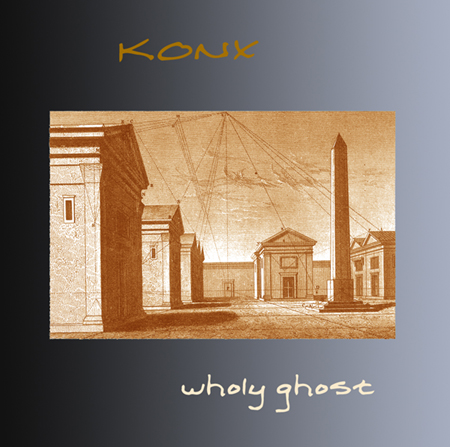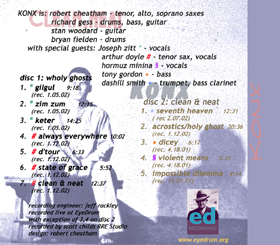
konx (om pax)
Fehta Murghana
(we are grateful to the estate of Ms. Murghana for allowing us to use
this material. I had asked her to prepare some liner notes awhile before
her demise and then forgot about it. As an Islamic folklorist, last work
was the concept of djinn in al-Andalus.
40 Or like darkness on a deep sea, there covers it a wave above
which is a wave, above which is a cloud, -- darknesses one above the
other, --when one puts out his hand he can scarcely see it; for he to
whom God has given no light, he has no light.
Koran
sura 24 v. 40)
Aaaah! Now we begin to see where the name ‘Konx’ comes from! (Often phonetically transliterated into ‘knox’, it is sometimes in fact found that way in the ancient literature.) We were originally assured that ‘konx’ (also called ‘conk’) was a slippage for a ‘konk’ or a processed hair style of hep cats in the african american community in the 1940’s and 50’s which flattened the curls, laying the hair tight against the skull. As a web site has it: “But conks, just like James Brown himself, were really beyond the law. What they denoted was aesthetic certitude - plus a spirit of true improvisation.”
Also undoubtedly to ‘konk out’ means to go unconscious, for
your head to stop working....perhaps at least a partial prerequisite in
some sense for improvisation in that one has to move through the material
in an unpre-media-tated manner. Epiphanies may visit those who are in
some sense prepared but it is to the unknowing that the most impact is
felt. After all, light is most forceful to those who are suddenly deprived
of the dark.
Now we come to find that the term is associated with both the Italian
composer Giancinto Scelsi and occultist Aleister Crowley though the use
of the phrase ‘konk om pax’. (1). Scelsi wrote a large orchestra
piece in the mid-sixties called ‘Konk-om-pax’ but get this:
his main method of composition was in fact improvisation which he then
had someone else notate.
And of course there is the slim obscure book on the kabala by Crowley
written in 1907 called ‘Konx Om Pax’. A selection: “till
Konx om Pax replace Reading without Tears in every Infant School”
and “It is one of the most suggestive definitions of KONX [....]
that it transcends all the possible pairs of opposites.”
Perhaps good guidelines for certain improvisors.
But then what does ‘Konx om pax’ mean? it literally means ‘Light
In Extension,’ a mystical precept coming from ancient Egypt. As we
can see in the document below, the phrase itself seems to be a corrupt
improvised fragment descending from ancient sources. The phrase seems
to imply an embodiment of light, or , as it has been metaphorized through
the European Enlightment, the Truth as it has been given an autonomized
form (‘in entension.’ i.e., outside the etherialized provinces
of whatever heavens or planes or dimensions that Truth is supposed to
emanate from.) Certainly, as a species whose main organ and register of
‘truth’ is the optic this has great import but we might also
ask if there can be an equivalent for the sonic, since in conditions of
darkness (whether ontological, ethical, or cultural) sound would seem
to take on an added significance. For example, language becomes of even
greater import when manipulations of ‘light in extension’ (via
the emerging kybernetic world) create conditions of great instabity and
uncertainty.
At any rate, there is an uncanny sense of a mechanicalization here, of
the making of an optical engine, when light becomes autonomous; there
is an inevitability concerning the process (although only time can tell
of the necessity of its occurrence; that is, Truth -- as Light -- walking
the land by itself, unencumbered by hermeneusis.)
There is an immediacy implied in the formulation which more than suggests
the improvisational, but that inhabits the improvised and makes it ‘walk’
and which points to a now-occulted entry point for the ability to ‘walk’
(one thinks of the cabalistic concept of the golem here which is animated
by the hebrew words for truth inscribed on its ... head.
Simultaneously with this concept of the improvised as an unencumbered
movement of ‘truth,’ it is undermined and turned into a mechanical
puppet, doll, or automaton which is still centrally coordinated since
truth must in some sense refer to axial arrangements, symmetries, and
coordinations from outside the immediacy of movement, otherwise chaotic
randomness governs. (We note that this is in fact what complexity theory
and certain aspects of quantum mechanics imply and that in fact this ‘coordination
of truth’ or ‘light in extension’ or ‘konx om pax’
can be mathematized, hypothesized, and perhaps in some sense ‘made
mechanical’ but that intuitive human understanding will never grasp
it, and that in fact the only relationship to it can be the improvised,
as some post modern variation of Pascal’s wager or the old saying
that ‘no matter where you go, there you are.’)
The feeling of ‘being there’ (whilst simulaneously and necessarily
being ‘absented’) is entirely the province of the improvisational
and all its complications, failures and liabilities. (2) This music you
hold in your hand (and will shortly put ‘in extension’) fuses
all these characteristics in a sometimes overpowering mix and makes us
think that, after all this, Light can indeed walk.
notes
1. “The words ‘Khabs am Pekht, which accompany the Golden Dawn ritual knocks, ‘seal the image of the light.’ and were first given by the 17th century writer Meursius (according to David Godwin on Pg. 71 his wonderful work, “Light in Extension”). The document Z1 says, ‘their significance implies, by various Qabalistic methods of analysis, as well as by a certain reading of the Coptic and Egyptian hieroglyphics, Light in Extension, or may light be extended in abundance upon you. Konx om Pax is the corrupted pronunciation of this, put here to link it with its right origin.’ Another translation is ‘Light rushing out in one ray.’
Recent investigation, with the assistance of the British Museum, has revealed
that the most probable Egyptian origin for this phrase is hbs m pht, pronounced
khebs m pekht. The word khebs actually means star or lamp rather than
light, and the word pekht is a noun from the verb pekh, meaning to reach
or attain. The museum thought that extension was a possible but unlikely
translation.
Thus, the most accurate translation of “Khabs am Pekht” is rendered
as the attainment of the star, a phrase of particular and peculiar significance.
The corruption Konx om Pax is, at least according to the museum, “a
complete mystery, being neither Greek nor Coptic nor indeed a rendering
of the hieroglyphics”. As the Fellowship of Isis documents note,
“initiates [of the Elusian Mysteries] were dismissed with two barbarous
words, Konx Ompax, of which perhaps the Hierophants themselves did not
comprehend the import they had been introduced by the first Egyptian mysteries.
To us the words in question appear to be Syriac, and signify, be vigilant,
be innocent.” Another offered version is light is strength.
2. ("The three principles constituting allegorical poiesis
are parallel with, while differing fundamentally from, the triad of matter,
negation, and form: monumentality, violence, and improvisation."
[....]
"The third principle, improvisation, has obvious relevance to the
example of Homeric diction, as it does to the combinative dexterity of
spontaneous composition in music. Far from being a deviation from the
norm in the arts of the West these practices disclose what is essential
to making. In even the most rigorously classical composition order is
achieved by working with chance. A structure is developed gradually out
of the chaotic interactions between the mind of the artist and the materials
at hand, that is, the fragments of previous works. At the most fundamental
level, poiesis is a schematizing of fragments of the previously made.
Through a complex process of struggle among layered revisions, these fall
into a pattern that cannot be foreseen but only revealed as it emerges
in time."
"The concept of improvisation appears in Aristotle’s Poetics,
where it denotes the unskilled, haphazard manner of working which was
gradually displaced by the poets as they developed their art. At the beginning
of Western aesthetics the technological theory of making is founded on
the concept of improvisation as amateurish, ignorant. The verb ‘to
improvise’ is autoschediazein, implying the self-development of an
external form, a schema, as one proceeds, rather than working with a preexisting
idea according to a preexisting rule. While the word was generally used
in a perjorative sense, it has a positive application in complex systems
that change over time, compelling one to rely on instinctive impulse rather
than on rules. In Thucydides and Xenophon improvisation is associated
with political and military genius, with a sure sense of timing and of
touch, nourished by experience, empathy, and talent. These are of course
the very qualities we associate also with lasting achievement in the arts.
Now allegory is unusual among the older literary genres in being a more
openly improvisatory form. It therefore provides us with an occasion to
reflect on the wider significance of the two models of artistic production
being considered here: technological making, the imposition of form on
indifferent substance, and schematic, or improvisational, making."
Allegory and Violence
Gordon Teskey 163-165)
